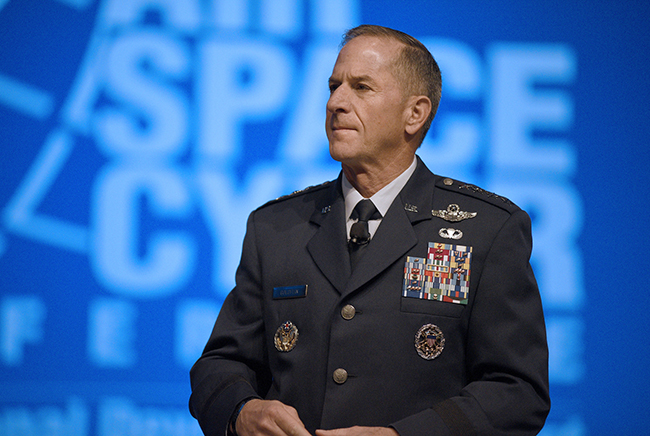
Air Force Chief of Staff Gen. David Goldfein delivers a keynote address during AFA's 2019 Air, Space & Cyber Conference in National Harbor, Md., near Washington, D.C. Staff photo by Mike Tsukamoto.
The Air Force is drawing up new force designs as it acknowledges its 2018 plan to reach 386 combat squadrons probably won’t materialize, service leaders said Sept. 17 at AFA’s 2019 Air, Space & Cyber Conference.
However, if the service achieves its vision of connecting assets so they can share data and communicate in new ways, a smaller force may be sufficient, Chief of Staff Gen. David Goldfein said. Acting Air Force Secretary Matt Donovan said new blueprints for what platforms and how many the service should own should be ready in the spring.
Getting to 386 squadrons—about a 25 percent increase over today’s force—is “not likely,” Goldfein told reporters. “But I’m not going to back away an inch from that requirement.”
A force of that size would pose moderate risk to the service’s ability to meet future combat needs, Goldfein said without further explanation. The Air Force worked through thousands of combinations of notional fleet mixes for bombers, fighters, tankers, and more before finding the best option, he added.
Goldfein said it’s now up to the Air Force to make trade-offs between those portfolios—and their capacity, capabilities, and readiness—to reach the right solution within the multibillion-dollar budget provided by Congress. As the service looks to create new networks of sensors that detect noteworthy enemy movements and send that information to other forces that could react, that mindset is influencing the shape of the future force.
“As technology advances and you start connecting things that were not previously connected, it actually impacts your numbers required,” Goldfein said.
For example, the military could piece together the B-52 bomber, the X-37 unmanned space plane, the RQ-170 stealth reconnaissance aircraft, a tactical submarine and an Army High Mobility Artillery Rocket System for an unforeseen result.
“If we connect them, we’re going to have options available that we can throw at the adversary that today are not available,” Goldfein said. “That will affect our numbers.”
Last year’s “Force We Need” paper rolled out in response to Congress, which was frustrated by what it perceived as the Air Force asking for assets based on the money it expected to receive, rather than requesting what it needed to meet evolving national security requirements, Donovan said.
“Congress, and my former boss, Sen. [John] McCain, would always ask, ‘What are the requirements’” Donovan said. “Then the National Defense Strategy came out.”
The 2018 NDS pointed to China and Russia as America’s two greatest potential adversaries, which the US would need to deter or defeat in a possible conflict while also juggling threats from North Korea, Iran, and violent extremism in the Middle East and Africa.
Congress asked the Air Force to submit three studies to define a “moderate-risk” force. Those were eventually completed by MITRE Corp., the Center for Strategic and Budgetary Assessments, and the service itself. Each took a slightly different approach but largely came to the same results, Donovan said.
The acting secretary added that the Air Force is working on a follow-up report that answers the Senate Armed Services Committee’s call in current legislation for an “optimum” fighter and bomber plan that can counter Russia and China. That report is due by March 2020.
“The committee is concerned that the Air Force’s current fighter force structure acquisition strategy does not comport with multiple reports required by the National Defense Authorization Act for Fiscal Year 2018, nor the service’s own stated requirements to meet the National Defense Strategy,” lawmakers wrote in the report accompanying SASC’s version of the 2020 defense policy bill.
Senators want to block any deviation from the final strategy until the Air Force receives a waiver from the defense secretary to do so, and until 30 days after notifying Congress of any changes.
Donovan said the Air Force Warfighting Integration Capability planning group is using wargame results and threat analyses to complete the new report.
“Whether we get to the 386 is not a question for the United States Air Force,” Goldfein added. “That’s a question for the Congress and the nation to answer, relative to the resources that are provided.”